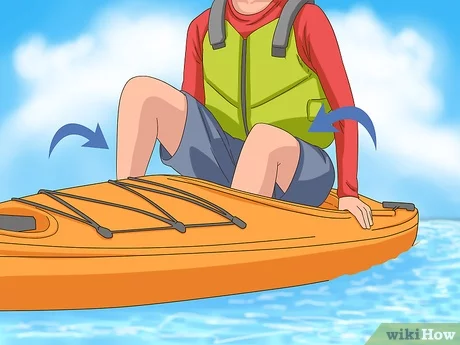How to Sit in a Kayak | Step By Step Guide for 2024
How to sit in a kayak correctly is essential for both comfort and control while paddling. Sitting in a kayak may seem straightforward, but there are some essential tips to keep in mind. First, locate the seat and position yourself in front of it.
Sit down with your legs in front of you, keeping them straight and close together. Place your feet on the footpegs, and adjust the footpegs to fit your feet comfortably. Ensure that your back is straight and well-supported by the kayak’s backrest. Finally, adjust your paddle’s length and position it across your lap to prepare for paddling. Remember to sit up straight, engage your core muscles, and enjoy the ride!

How to Sit in a Kayak? 9 Steps
- Approach the kayak: Place the kayak on a stable surface, such as sand or grass, near the water. Make sure the kayak is parallel to the shoreline and the bow (front) is pointing towards the water.
- Check the footpegs: Before getting in, ensure the footpegs are adjusted to your leg length. You should be able to comfortably press the balls of your feet against the pegs with your knees slightly bent. If they’re not adjusted correctly, adjust them before getting in.
- Hold the kayak steady: Stand behind the cockpit (the opening where you sit) and hold the sides of the kayak with both hands to keep it steady.
- One foot in: Place one foot in the center of the cockpit while keeping your other foot on the ground for balance.
- Lower your body: Slowly lower your body into the seat, keeping your weight centered. Make sure to hold onto the sides of the cockpit for stability.
- Position your legs: Slide your other foot into the cockpit and place both feet on the footpegs. Your legs should be bent slightly and comfortably splayed outwards. This position allows you to apply pressure to the thigh braces, which helps you control the kayak.
- Sit back: Sit back comfortably in the seat, ensuring your lower back is supported by the backrest. Adjust the backrest if necessary to achieve a comfortable and snug fit.
- Hold the paddle: Once you’re seated, grab your paddle with both hands. Hold the paddle with your hands shoulder-width apart and your knuckles facing upwards. The paddle blades should be parallel to each other.
- Ready to launch: Now that you’re properly seated, you can use your paddle to push off from the shoreline and start your kayaking adventure.
Remember to always wear a personal flotation device (PFD) when kayaking, and familiarize yourself with safety guidelines and techniques before heading out on the water.
Also, Read Best Life Jackets for Kayaking
FAQ’s
Q: Why is it important to sit correctly in a kayak?
Sitting correctly in a kayak ensures comfort, stability, and control while paddling. It also helps prevent muscle strain and fatigue during long paddling sessions.
Q: How should I position my legs while sitting in a kayak?
A: Your legs should be slightly bent, with your feet resting on the footpegs and your knees splayed outwards to make contact with the thigh braces. This position allows you to control the kayak effectively.
Q: How do I adjust the footpegs in a kayak?
Most kayaks have adjustable footpegs that can be moved forward or backward to accommodate different leg lengths. Simply slide the footpeg along its track until it’s in a comfortable position and then lock it in place.
Q: What should I do if I start feeling uncomfortable or sore while sitting in a kayak?
If you experience discomfort, take a break and stretch your legs. Make sure to adjust the seat or backrest if necessary for better support. Maintaining a good posture and occasionally shifting your position can also help alleviate discomfort.
Q: How do I know if my kayak seat is adjusted correctly? A: A properly adjusted kayak seat should provide support for your lower back and allow you to sit upright comfortably. You should be able to maintain a relaxed and comfortable posture without straining any muscles.
Q: Is it necessary to wear a personal flotation device (PFD) while kayaking?
Yes, wearing a PFD is crucial for your safety while kayaking. It helps you stay afloat in case you capsize or fall out of the kayak. Always ensure your PFD is properly fitted and securely fastened before getting on the water.
Q: How do I hold a kayak paddle correctly?
Hold the paddle with both hands shoulder-width apart, and your knuckles facing upwards. The paddle blades should be parallel to each other. This grip provides optimal control and power while paddling.
Q: Can I use any kayak for my paddling needs?
Different kayaks are designed for various purposes, such as recreational, touring, or whitewater kayaking. Choose a kayak that suits your intended use and skill level to ensure a safe and enjoyable paddling experience.
Q: How do I get out of a kayak safely?
To exit a kayak safely, paddle to a stable shoreline or landing area. Hold onto the sides of the cockpit and shift your weight to one side. Swing one leg out of the cockpit and onto the ground, then use your hands to push yourself up and out of the kayak while keeping your weight centered.
Conclusion
In conclusion, sitting in a kayak is a crucial skill for anyone who wants to enjoy kayaking. To sit properly, ensure you have good posture, keep your feet in the footpegs, and adjust the seatback to fit your comfort level. With these simple steps, you can enjoy a comfortable and safe kayaking experience.





